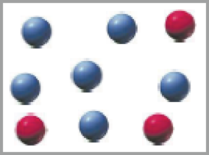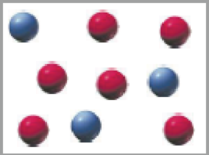
The following reaction is first order in A (red spheres) and first order in B (blue spheres):




- (a) What are the relative
rates of this reaction in vessels (1)–(4)? Each vessel has the same volume. - (b) What are the relative values of the rate constant k for cases (1)–(4)?
(a)
Interpretation:
The relative rates of the reaction in the given vessels has to be given.
Concept introduction:
Rate of reaction:
The rate of a reaction is defined by the change in concentration of substrate (reactant) or target (product) with change in time.
Answer to Problem 12.24CP
The relative rates of the reaction in the given vessels (1) – (4) are
Explanation of Solution
Given reaction and information,

Figure 1
Given as
Hence, the rate of reaction is proportional to the product of the number of
In the vessel (1), the product of
In the vessel (2), the product of
In the vessel (3), the product of
In the vessel (4), the product of
Therefore, the relative rates of the reaction in the given vessels (1) – (4) are
(b)
Interpretation:
The relative values of rate constants of the given reaction has to be given.
Concept introduction:
Rate law:
It is an equation that related to the dependence of the reaction rate on the concentration of each substrates (reactants).
Answer to Problem 12.24CP
- The relative values of rate constant for all the given reactions are same.
Explanation of Solution
Given reaction and information,

Figure 1
Given as
Hence, the rate of reaction is proportional to the product of the number of
The relative of the reaction in vessels (1) – (4) are
The relative value of rate constant for all the given reactions are same. Since, the same reaction takes place in each of the given vessels (1) – (4).
Want to see more full solutions like this?
Chapter 12 Solutions
General Chemistry: Atoms First
- Sucrose, a sugar, decomposes in acid solution to give glucose and fructose. The reaction is first-order in sucrose, and the rate constant at 25 C is k = 0.21 h1. If the initial concentration of sucrose is 0.010 mol/L, what is its concentration after 5.0 h?arrow_forwardFor a reaction involving the decomposition of Z at a certain temperature, the following data are obtained: (a) What is the order of the reaction? (b) Write the rate expression for the decomposition of Z. (c) Calculate k for the decomposition at that temperature.arrow_forwardRegular ?ights of supersonic aircraft in the stratosphere ale of concern because such aircraft produce nitric oxide, NO, as a byproduct in the exhaust of their engines. Nitric oxide reacts with ozone, and it has been suggested that this could contribute to depletion of the ozone layer. The reaction NO+O3NO2+O2 is first order with respect to both NO and O3 with a rate constant of 2.20107 L/mol/s. What is the instantaneous rate of disappearance of NO when [NO]=3.3106 M and [O3]=5.9107M?arrow_forward
- For a reaction involving the decomposition of a hypothetical substance Y, these data are obtained: Determine the order of the reaction. Write the rate law for the decomposition of Y. Calculate k for the experiment above.arrow_forwardThe hydrolysis of the sugar sucrose to the sugars glucose and fructose, C12H22O11+H2OC6H12O6+C6H12O6 follows a first-order rate equation for the disappearance of sucrose: Rate =k[C12H22O11] (The products of the reaction, glucose and fructose, have the same molecular formulas but differ in the arrangement of the atoms in their molecules.) (a) In neutral solution, k=2.11011s1 at 27 C and 8.51011s1 at 37 C. Determine the activation energy, the frequency factor, and the rate constant for this equation at 47 C (assuming the kinetics remain consistent with the Arrhenius equation at this temperature). (b) When a solution of sucrose with an initial concentration of 0.150 M reaches equilibrium, the concentration of sucrose is 1.65107M . How long will it take the solution to reach equilibrium at 27 C in the absence of a catalyst? Because the concentration of sucrose at equilibrium is so low, assume that the reaction is irreversible. (c) Why does assuming that the reaction is irreversible simplify the calculation in pan (b)?arrow_forwardThe catalyzed decomposition of hydrogen peroxide is first-order in [H2O2]. It was found that the concentration of H2O2 decreased from 0.24 M to 0.060 M over a period of 282 minutes. What is the half-life of H2O2? What is the rate constant for this reaction? What is the initial rate of decomposition at the beginning of this experiment (when [H2O2] = 0.24 M)?arrow_forward
- The frequency factor A is 6.31 108 L mol1 s1 and the activation energy is 10. kJ/mol for the gas-phase reaction NO(g)+O3(g)NO2(g)+O2(g) which is important in the chemistry of stratospheric ozone depletion. (a) Calculate the rate constant for this reaction at 370. K. (b) Assuming that this is an elementary reaction, calculate the rate of the reaction at 370. K if [NO] = 0.0010 M and [O3] = 0.00050 M.arrow_forwardA drug decomposes in the blood by a first-order process. A pill containing 0.500 g of the active ingredient reaches its maximum concentration of 2.5 mg/ 100 mL of blood. If the half-life of the active ingredient is 75 min, what is its concentration in the blood 2.0 h after the maximum concentration has been reached?arrow_forwardThe decomposition of iodoethane in the gas phase proceeds according to the following equation: C2H5I(g)C2H4(g)+HI(g) At 660. K, k = 7.2 104 sl; at 720. K, k = 1.7 102 sl. What is the value of the rate constant for this first-order decomposition at 325C? If the initial pressure of iodoethane is 894 torr at 245C, what is the pressure of iodoethane after three half-lives?arrow_forward
- The decomposition of N2O5 in CCl4 is a first-order reaction. If 2.56 mg of N2O5 is present initially and 2.50 mg is present after 4.26 minutes at 55 C, what is the value of the rate constant, k?arrow_forwardExpress the rate of the reaction 2N2O(g)2N2(g)+O2(g) in terms of (b) [ N2O ] (a) [ O2 ]arrow_forwardExplain why half-lives are not normally used to describe reactions other than first order.arrow_forward
 Chemistry for Engineering StudentsChemistryISBN:9781285199023Author:Lawrence S. Brown, Tom HolmePublisher:Cengage Learning
Chemistry for Engineering StudentsChemistryISBN:9781285199023Author:Lawrence S. Brown, Tom HolmePublisher:Cengage Learning Chemistry & Chemical ReactivityChemistryISBN:9781337399074Author:John C. Kotz, Paul M. Treichel, John Townsend, David TreichelPublisher:Cengage Learning
Chemistry & Chemical ReactivityChemistryISBN:9781337399074Author:John C. Kotz, Paul M. Treichel, John Townsend, David TreichelPublisher:Cengage Learning Chemistry & Chemical ReactivityChemistryISBN:9781133949640Author:John C. Kotz, Paul M. Treichel, John Townsend, David TreichelPublisher:Cengage Learning
Chemistry & Chemical ReactivityChemistryISBN:9781133949640Author:John C. Kotz, Paul M. Treichel, John Townsend, David TreichelPublisher:Cengage Learning Chemistry by OpenStax (2015-05-04)ChemistryISBN:9781938168390Author:Klaus Theopold, Richard H Langley, Paul Flowers, William R. Robinson, Mark BlaserPublisher:OpenStax
Chemistry by OpenStax (2015-05-04)ChemistryISBN:9781938168390Author:Klaus Theopold, Richard H Langley, Paul Flowers, William R. Robinson, Mark BlaserPublisher:OpenStax Chemistry: The Molecular ScienceChemistryISBN:9781285199047Author:John W. Moore, Conrad L. StanitskiPublisher:Cengage Learning
Chemistry: The Molecular ScienceChemistryISBN:9781285199047Author:John W. Moore, Conrad L. StanitskiPublisher:Cengage Learning Chemistry: Principles and ReactionsChemistryISBN:9781305079373Author:William L. Masterton, Cecile N. HurleyPublisher:Cengage Learning
Chemistry: Principles and ReactionsChemistryISBN:9781305079373Author:William L. Masterton, Cecile N. HurleyPublisher:Cengage Learning





